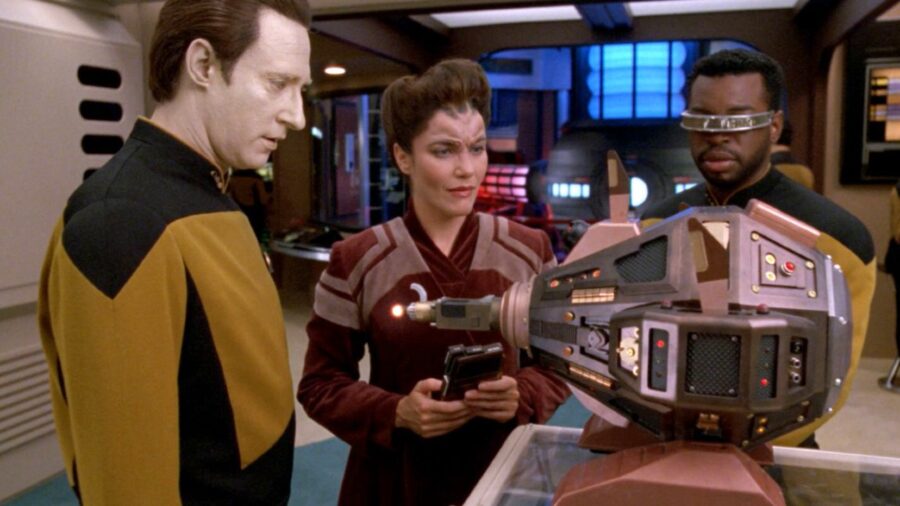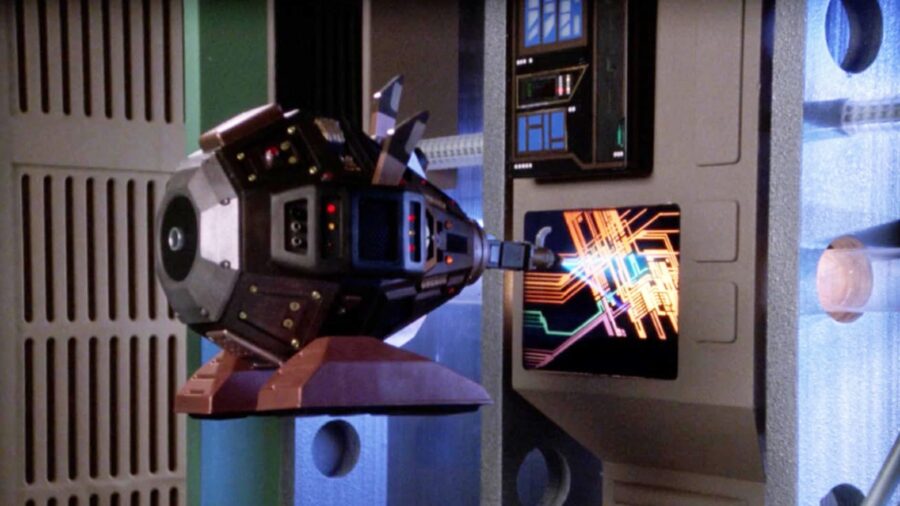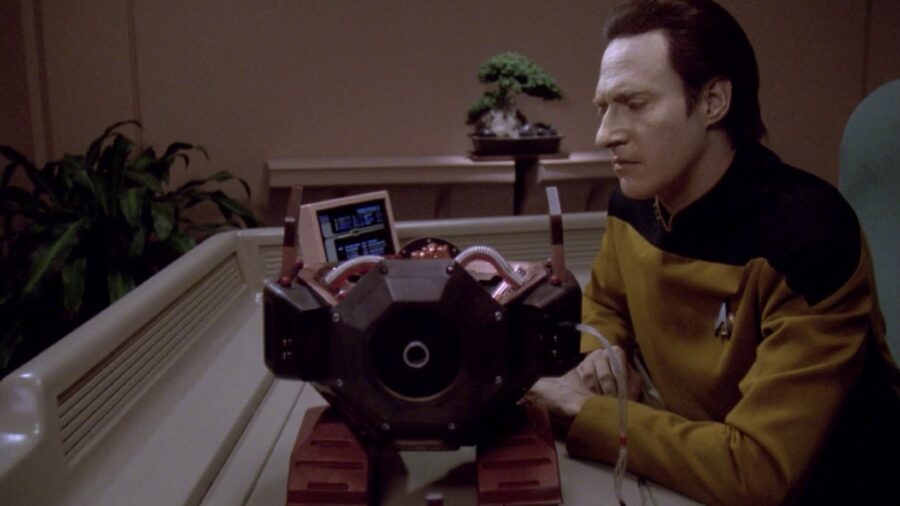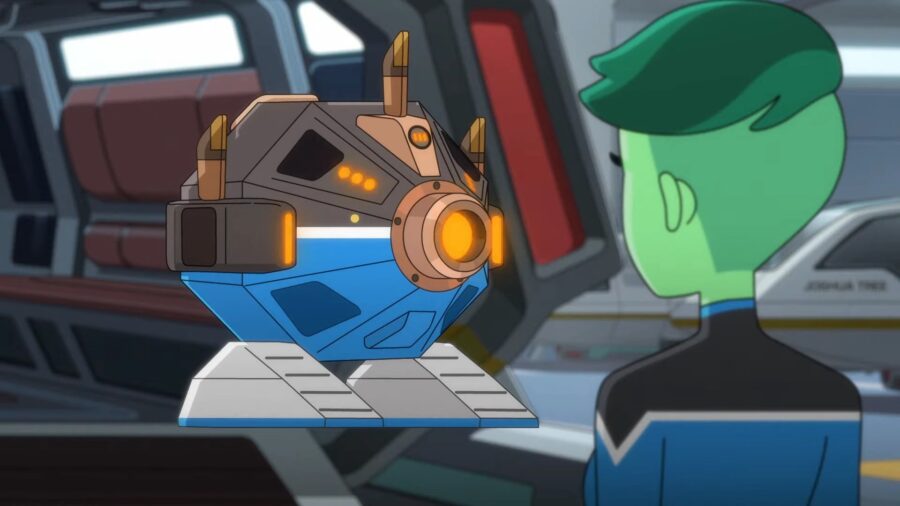Star Trek’s Exocomps: The Sentient AI Explained

Star Trek’s design philosophy has been all over the place, and this was never more apparent than when The Next Generation introduced us to the exocomps in the episode “Quality of Life.” Visually, these guys look more like steampunk than sci-fi, but the concept behind this surprisingly sentient AI is vintage science fiction. Hold on to your tricorders with the purple stripe because we’re about to explain everything you need to know about Star Trek’s exocomps.
We look into the history of Star Trek’s exocomps, the watermelon-sized robots capable of sentience.
Back in Star Trek: The Next Generation, these guys were invented by Doctor Farallon. She wanted to develop a kind of all-in-one solution to a variety of technical problems encountered by residents in places like the moon of Tyrus VIIA. To this end, the exocomps are packed with many specialized gadgets.
To begin with, the exocomps have a miniature replicator inside of them and a boridium power converter to keep them energized. It gets major computing power from its onboard axionic chip, and that computer would help these Star Trek devices calculate which tools would be needed to solve the latest problems.

At first, the exocomps seemed like a miracle device because they could autonomously solve almost any problem, but Doctor Farallon added one more feature that led to some very unexpected consequences: these exocomps were designed to learn and grow based on each new problem they learned how to solve.
Exocomps are introduced in the Star Trek: The Next Generation episode “Quality of Life.”
On paper, that sounded like a good idea because the exocomps would only get more creative and efficient over time, but in typical Star Trek fashion, this ability to constantly learn helped the exocomps gain sentience. The android Commander Data discovered this in the TNG episode “Quality of Life” when an exocomp refused to seal a plasma conduit even after Doctor Farallon issued a command override that caused her control pad to overload.
When the plasma conduit exploded soon after, Data and Engineer Geordi LaForge began to suspect that the exocomp had refused commands in order to preserve its life.
As you might expect from a good Star Trek episode, Data began conducting a series of tests that helped him determine to his satisfaction that the exocomps were sentient. Things came to a head when the Enterprise needed to disrupt a particle fountain and made plans to essentially beam the exocomps into the particle stream as rigged bombs. Data actually locked out transporter controls, refusing an order that would have led to the loss of this new sentient life.

Thinking outside the box, Riker suggested communicating with the exocomps and asking whether they would be willing to carry out what was essentially a suicide mission. The exocomps tackled this crazy Star Trek problem by coming up with a safer solution. Still, their mission success came at great cost: one of the exocomps died because he had to stay behind to disrupt the stream.
After everyone saw the exocomp make his Spock-like sacrifice, this Star Trek: The Next Generation episode ended with Doctor Farallon vowing to learn more about these new beings and to stop treating them as lifeless tools. Fans went decades without hearing more about the exocomps, but they popped back up in a big way in the Star Trek: Lower Decks episode “No Small Parts.”
The Exocomp Peanut Hamper most recently appeared in the Star Trek: Lower Decks Season 4 episode “A Few Badgeys More.”
In that ep, we discover that the Federation now considers exocomps to be sentient artificial lifeforms, and the sentient AI devices have now learned how to talk directly with the humanoids around them.

In Star Trek: Lower Decks, we get introduced to the exocomp character Peanut Hamper, who had become the first commissioned exocomp officer in Starfleet. She served aboard the USS Cerritos, but the creature ended up being a bit of a coward: when faced with a risky rescue mission where it would encounter fearsome Pakleds, Peanut Hamper beamed off the Cerritos entirely, admitting that she only joined Starfleet to make her exocomp dad Kevin angry.
Later, she manipulated the natives of the planet Areolus in a failed bid to get back into the Cerritos crew’s good graces, and this led to her getting imprisoned in the Daystrom Institute’s Self-Aware Megalomaniacal Computer Storage section, where she completes her transformation into a villain. Scarier still, she made a frightening new friend in the form of fellow evil AI AGIMUS.
We like to think that Peanut Hamper is just one bad apple and that the rest of the exocomps in Star Trek are a lot nicer. We won’t know, though, until we see a few more of these cybernetic characters onscreen. At the very least, we can only hope the next exocomp character we meet in this Paramount franchise isn’t quite as murderous and manipulative as Badgey.












